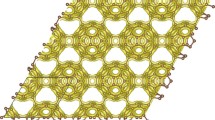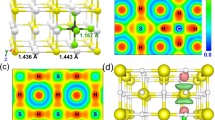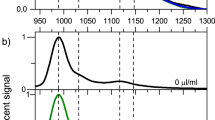Abstract
The observation of superconductivity in doped C60 has attracted much attention1,2,3, as these materials represent an entirely new class of superconductors. A maximum transition temperature (Tc) of 40 K has been reported4 for electron-doped C60 crystals, while a Tc of 52 K has been seen5 in hole-doped crystals; only the copper oxide superconductors have higher transition temperatures. The results for C60 raise the intriguing questions of whether conventional electron–phonon coupling alone1 can produce such high transition temperatures, and whether even higher transition temperatures might be observed in other fullerenes6,7,8. There have, however, been no confirmed reports of superconductivity in other fullerenes, though it has recently been observed in carbon nanotubes9. Here we report the observation of superconductivity in single crystals of electric-field-doped C70. The maximum transition temperature of about 7 K is achieved when the sample is doped to approximately four electrons per C70 molecule, which corresponds to a half-filled conduction band. We anticipate superconductivity in smaller fullerenes at temperatures even higher than in C60 if the right charge density can be induced.
This is a preview of subscription content, access via your institution
Access options
Subscribe to this journal
Receive 51 print issues and online access
$199.00 per year
only $3.90 per issue
Buy this article
- Purchase on Springer Link
- Instant access to full article PDF
Prices may be subject to local taxes which are calculated during checkout


Similar content being viewed by others
References
Hebard, A. F. et al. Superconductivity at 18 K in potassium-doped C60. Nature 350, 600–601 (1991).
Ramirez, A. P. C60 and its superconductivity. Supercond. Rev. 1, 1–101 (1994).
Gunnarsson, O. Superconductivity in fullerides. Rev. Mod. Phys. 69, 575–606 (1997).
Palstra, T. T. M. et al. Superconductivity at 40 K in cesium doped C60. Solid State Commun. 93, 327–330 (1995).
Schön, J. H., Kloc, Ch. & Batlogg, B. Superconductivity at 52 K in hole-doped C60. Nature 408, 549–552 (2000).
Devos, A. & Lannoo, M. Electron-phonon coupling for aromatic molecular crystals: Possible consequences for their superconductivity. Phys. Rev. B 58, 8236–8239 (1998).
Cohen, M. L. Possibility of high temperature superconductivity in C36 and C24N12 solids. Am. Inst. Phys. Conf. Proc. 483, 359–365 (1999).
Piskoti, C., Yarger, J. & Zettl, A. C36, a new carbon solid. Nature 393, 771–774 (1998).
Tang, Z. K. et al. Superconductivity in 4 Å single-walled carbon nanotubes. Science 292, 2462–2465 (2001).
Haddon, R. C. et al. Conducting films of C60 and C70 by alkali-metal doping. Nature 350, 320–322 (1991).
Wang, Z. H., Dresselhaus, M. S., Dresselhaus, G. & Eklund, P. C. Raman studies of electron-phonon interaction in KxC70. Phys. Rev. B 48, 16881–16884 (1994).
Saito, S. & Oshiyama, A. Electronic and geometric structures of C70. Phys. Rev. B 44, 11532–11535 (1991).
Wang, Z. H. et al. Electronic properties of KxC70 thin films. Phys. Rev. B 48, 10657–10660 (1994).
Wang, Z. H., Dresselhaus, M. S., Dresselhaus, G., Wang, K. A. & Eklund, P. C. Electronic properties of KxC70 thin films. II. Phys. Rev. B 49, 15890–15900 (1994).
Takahashi, T. et al. Comparative photoemission study of RbxC60, RbxC70 and RbC8. A pseudo-gap at the Fermi level in the fulleride. Physica C 190, 205–209 (1992).
Chen, X. H. et al. Synthesis, structure, and transport properties of novel fullerides A3C70 (A = Ba and Sm). J. Am. Chem. Soc. 122, 5729–5732 (2000).
Schön, J. H., Kloc, Ch., Haddon, R. C. & Batlogg, B. A superconducting field-effect switch. Science 288, 656–658 (2000).
Schön, J. H., Kloc, Ch. & Batlogg, B. Superconductivity in molecular crystals induced by charge injection. Nature 406, 704–706 (2000).
Schön, J. H. et al. Gate-induced superconductivity in solution-processed, organic polymer films. Nature 410, 189–192 (2001).
Blanc, H.-B. et al. Single-crystal X-ray diffraction study of the room temperature structure and orientational disorder of C70. Europhys. Lett. 27, 359–364 (1994).
Blanc, E., Bürgi, H.-B., Restori, R., Schwarzenbach, D. & Ochsenbein, Ph. X-ray diffraction study of the stacking faults in hexagonal C70 single crystals. Europhys. Lett. 33, 205–210 (1996)
Bürgi, H. B. et al. The structure of C60: orientational disorder in the low-temperature modification of C60. Angew. Chem. Int. Edn Engl. 31, 640–643 (1992).
Wang, Z. H. et al. Electronic properties of KxC70 thin films. Phys. Rev. B 48, 10657–10660 (1994).
Ohno, K., Jing-Zhi, Y., Maruyama, Y., Kawazoe, Y. & Takahashi, T. Electronic structures of C70 crystalline phases. Chem. Phys. Lett. 255, 367–372 (1996).
Golden, M. S. et al. The electronic structure of fullerenes and fullerene compounds from high-energy spectroscopy. J. Phys. Condens. Matter 7, 8219–8247 (1995).
Kobayashi, M. et al. Structure sequence and possible superconductivity in potassium-doped fullerene C70Kx. Phys. Rev. B 48, 16877–16880 (1993).
Schluter, M., Lannoo, M., Needles, M. & Baraff, G. A. Electron-phonon coupling and superconductivity in alkali-intercalated C60 solid. Phys. Rev. Lett. 68, 526–529 (1992).
Acknowledgements
Access to beamline I711 at the MAX-II synchrotron storage ring in Lund is acknowledged.
Author information
Authors and Affiliations
Corresponding author
Rights and permissions
About this article
Cite this article
Schön, J., Kloc, C., Siegrist, T. et al. Superconductivity in single crystals of the fullerene C70. Nature 413, 831–833 (2001). https://doi.org/10.1038/35101577
Received:
Accepted:
Issue Date:
DOI: https://doi.org/10.1038/35101577
This article is cited by
-
Electronic and Spectroscopic Properties of La2@C112 Isomers
Chemical Research in Chinese Universities (2018)
-
Exohedral interaction in cationic lithium metallofullerenes
Theoretical Chemistry Accounts (2013)
-
Electron transmission and quantum current distribution of C70 molecule
Science in China Series G: Physics, Mechanics and Astronomy (2008)
-
Editorial statement
Nature (2002)
-
Bell Labs inquiry spreads to superconductors
Nature (2002)
Comments
By submitting a comment you agree to abide by our Terms and Community Guidelines. If you find something abusive or that does not comply with our terms or guidelines please flag it as inappropriate.



